12 Types of Koi Fish to Make Your Pond the Best Around
Author: Chris Miller | Editor: Omar Alonso
Review & Research: Jen Worst & Chris Miller
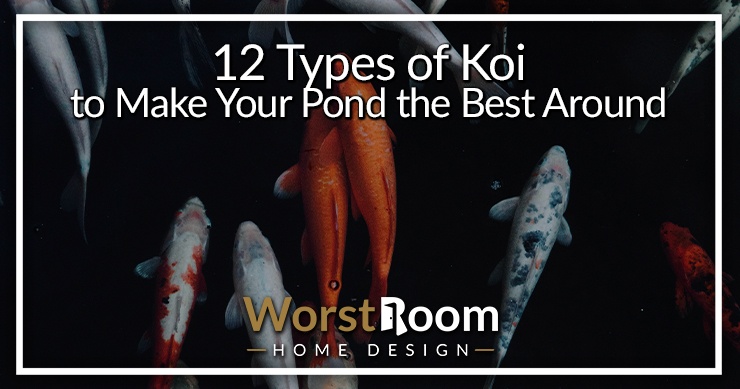
Commonly called jinli or nishikigoi and belonging to the Cyprinus rubrofuscus species, the many types of koi fish or brocaded carp are colorful ornamental fish that are usually seen in koi ponds and outdoor water features.
Developed mainly for their colors, beauty and vivid patterns, koi varieties can be differentiated on basis of their patterns, coloration and scales and are usually seen in colors like red, black, white, yellow, blue and cream.
Believed to have their origins in China, koi fish became a popular source of food for the Japanese and were later bred for their ornamental and aesthetic appeal. Koi are smart and hardy fish.
They are omnivorous and eat pond plants. Koi fish can grow up to 36 inches in length, have long lifespans and can live up to 50 years. They're native to fresh bodies of water around the Aral, Caspian, and Black Seas. They were domesticated in the 19th century and spread through the world.
Over 100 different types of koi varieties exist; however, only a few of them are very popular. These vibrant and attractive fish can add life and color to any pond or aquarium.
12 Types of Koi Fish
Koi are often referred to as "living jewels" or "swimming flowers" due to the beauty of their markings. Each koi variety is distinguished by its unique pattern and colors and if you want to know all about the different varieties of koi, read on.
Kohaku Koi Fish
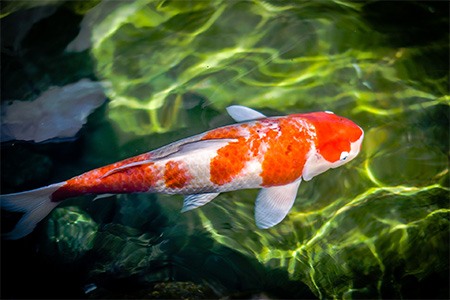
Kohaku, meaning “amber” in Japanese is regarded as the king of all koi fish varieties. This variety is popular for its simplistic, but majestic beauty.
Bred around the 1890s, the Kohaku koi has a beautiful white-colored or “shiroji” body with patches or red or hi, which can vary between dark red and orangish-red.
The hi pattern further distinguishes these koi fish types. For instance, the variety with the hi in a zigzag pattern is called Inazuma or “lightning strike” Kohaku.
The Kohaku koi have a yellow-colored nose and distinctive markings on the body, making them stand out. The majority of the Kohaku koi fish have a red-colored mark on the head, which is different from that on the rest of the body.
The body markings may sometimes however extend to the head and these Kohaku koi types are known as “bongiri.”
The fish without the red spot on the head is called “bozu.” Kohaku koi are indeed stunning fish and it’s no wonder, the saying goes, “appreciation of koi begins and ends with the Kohaku.”
There are different varieties of the Kohaku koi including Gin Rin Kohaku, Tancho Kohaku, Maruten Kohaku and Doitsu Kohaku.
Showa Sanshoku Koi Fish
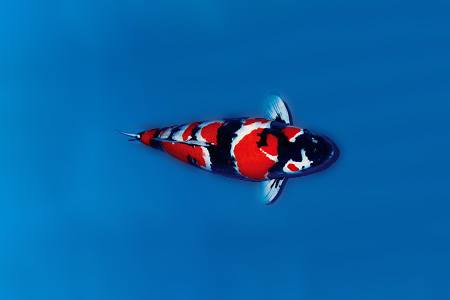
Also called Showa Sanke or simply Showa, the Showa Sanshoku koi are similar to the Sanke koi; however, the primary difference is that the Showa koi fish types have a black body (karasu) with white (shiroji) and red (hi) markings.
The Showa Sanshoku has a black-colored pattern running throughout their bodies and heads. The black, red and white-colored markings are uniformly distributed through the body of the Showa Sanshoku koi with clean and crisp margins between each of the colors.
The variations of the Showa Sanshoku koi are Maruten Showa, Gin Rin Showa, Tancho Showa, Kin Showa and Doitsu Showa. Have even one in your fish garden (one of the types of gardens for us to enjoy) and become a leader in your fish aficionado groups.
Taisho Sanke Koi Fish
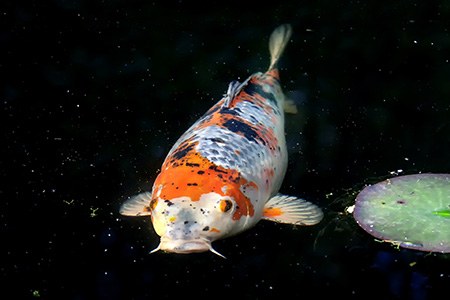
Developed from the Kohaku koi in the Taisho era in Japan, the Taisho Sanke types of koi fish, also called Taisho Sanshoku or Sanke, comprises 3 colors.
These colors include white (shiroji) body with an overlay of red (hi) and black (sumi) markings. The Taisho Sanke koi fish is considered to be amongst the “Big Three” in the koi fish world.
Usually, the Taisho Sanke’s head has 2 colors – red and white without any sumi (black) markings. Also, these fish have a clear face and the red markings that usually start from the top of the head.
They have white-colored pectoral fins with some black markings (tejima) on the fins. Variations of the Taisho Sanke koi type include Tancho Sanke, Maruten Sanke, Gin Rin Sanke and Doitsu Sanke.
Utsuri Koi Fish
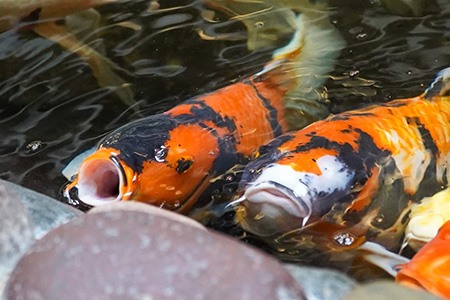
Utsuri, meaning “reflective ones” or “reflections” isn’t a single variety of koi fish but the name of the entire category, Utsurimono, which includes 3 variants of the Utsuri koi i.e., Hi Utsuri, Shiro Utsuri and Ki Utsuri.
All the 3 varieties of Utsuri have black bodies (karasu) with either white (shiroji), yellow (ki) or red (hi) markings. The Utsuri koi has a sumi (black) pattern on the head, which splits the face and also on the body just like the Showa koi.
The Utsuri koi fish has a pronounced reflective sumi pattern on the whole body below the lateral line. These markings spread from the nose to the tail and are balanced all through the body and also on either side of the dorsal line.
Some of the variations of the Utsuri koi types are Gin Shiro Utsuri, Gin Rin Shiro Utsuri and Doitsu Shiro Utsuri.
Bekko Koi Fish
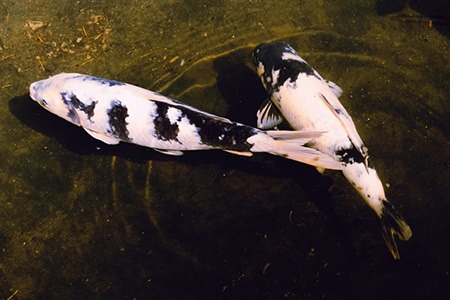
Meaning “tortoise shell,” Bekko koi fish are confused very often with Utsuri. Seeing them swim in your koi pond under whatever types of fountains you have is a majestic sight.
The characteristic feature distinguishing both these varieties is that while the Utsuri koi fish has red, yellow or white-colored markings on a black base, the Bekko has black-colored (sumi) markings on a red, yellow or white-colored base.
The Bekko koi fish breeds have a clear head, without any sumi markings. There are mainly 3 variants of the Bekko koi fish including the Aka Bekko (red-bodied), Ki Bekko (yellow-bodied) and Shiro Bekko (white-bodied), while the Shiro Bekko is the most common variety.
Tancho Koi Fish
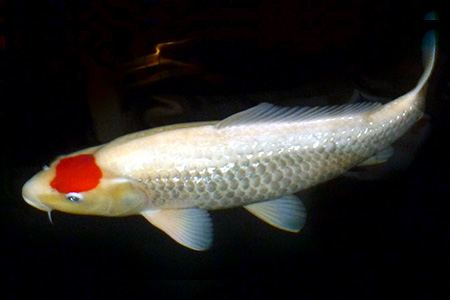
Named after the Grus japonensis or red-crowned crane, the national bird of Japan, the Tancho types of koi fish is a variation of the Kohaku koi fish.
This variety is sleek and simple and is characterized by its snow-white coloring with a prominent round or symmetrically shaped red spot on its head, which resembles the Japanese flag.
The spot on the head of the Tancho koi must be symmetrical, be it round, oval, diamond shaped or heart shaped. It must be large-sized and not speckled.
The koi also shouldn’t have any hi coloration on its body. Some of the varieties of Tancho are Tancho Sanke and Tancho Showa.
Asagi Koi Fish
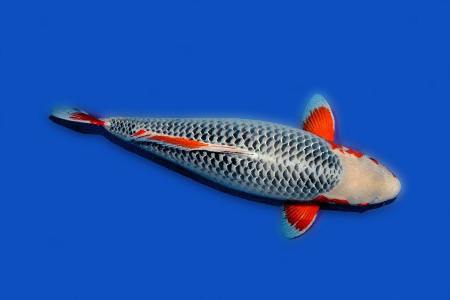
Among the oldest varieties of koi fish, Asagi koi are descendants of the wild Black Carp and their roots can be traced back to the 1860s.
These are stunningly beautiful fish with a net-like blue pattern on the body and reddish-orange coloring on their fins, body, belly and gill plates. As the fish grows older, the hi or red coloration spreads upwards.
There are 2 types of Asagi koi – the Hi Asagi, which has a red body and the Taki Asagi, which has the characteristic blue net pattern and red color with white-colored scales running between blue and red colors of the body.
Usually, Asagi koi fish have a clear pale blue or white head and don’t have any markings. Let them swim in your koi pond surrounded by pale types of bamboo and you'll have a magical garden going.
Shushui Koi Fish
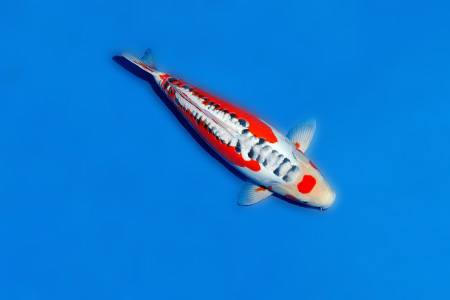
Meaning “autumn green”, Shusui koi fish were developed in 1910 by breeding the German Mirror Carp with Asagi. The Shusui koi types are a scale-less or Doitsu version of the Asagi.
Because there are no scales on the body, the blue net pattern is absent. The body has a row of scales running along the dorsal line.
The Shusui koi fish breeds have a white or pale blue colored head, which doesn’t have any spots or markings. The fish may have extended, red-colored cheeks, which is quite a common feature.
The fish doesn’t have specific markings on the body. But it has a row of uniform scales that run along the back of the fish. The variety of Shusui having mirror scales along both their lateral lines are known as Hana Shusui.
Koromo Koi Fish
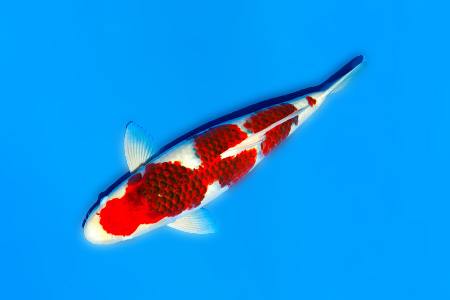
Also called Goromo, this gorgeous koi fish variety is a cross-breed of the Kohaku and Asagi koi fish, which is characterized by the red and white colors of the Kohaku koi fish and the Asagi koi’s distinctive blue-colored net pattern.
The Goromo types of koi fish have a white-colored body with a red-orange and a blue net pattern of scales, present on the red-colored patches.
There are essentially 3 varieties of Goromo i.e., Aigoromo, which has an ai (scales with an edge of indigo-blue color) within the hi or red-colored patterns. Seeing them swim among the types of dragonflies you'll attract is really something else.
The Sumi Goromo variety has a sumi (scales having an edge of black color) within the hi or red-colored patterns and the Budogoromo koi fish, which has a hi (red-colored pattern) with a sumi pattern, giving the hi pattern, a “budo” or grape-like appearance.
Goshiki Koi Fish
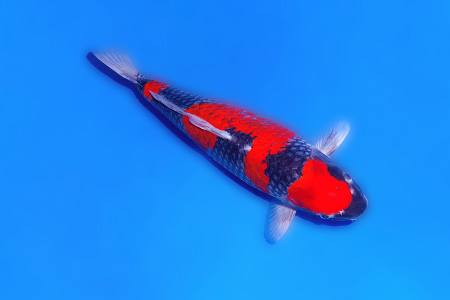
Meaning “five colors” the Goshiki koi fish is a crossbreed between Kohaku and Asagi koi fish. It has a white body with a black-blue colored net pattern that spreads all over the body.
The Goshiki has a hi (red-colored) plate from the Kohaku koi fish and an over the net pattern from the Asagi koi fish.
The fish gets its name Goshiki from its different colors i.e., red-orange or hi plate, blue-black net pattern over the white base.
The hi (red) plate becomes dense and thick as the Goshiki koi fish ages and appears like a sticker on the fish’s body and the net pattern disappears leaving behind only the red plate.
Hikari Koi Fish
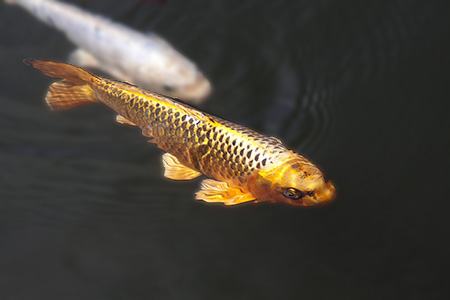
Meaning “shining” in Japanese, Hikari describes the metallic, reflective, shiny scales of the Hikari koi fish. These fish, with their polished gunmetal coloring, are simply stunning.
Hikari koi types come in 3 varieties—Hikarimuji or single-colored metallic koi, Hakarimoyo or multi-colored metallic koi and Hikariustsuri or metallic koi, which are also Urisiri or Showa.
Kawarimono Koi Fish
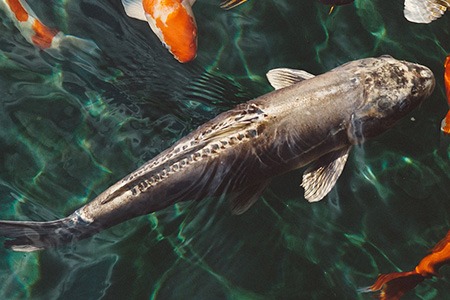
Also, known as Kawarigoi, Kawarimono koi fish breeds are non-metallic koi fish varieties that don’t fit into any other category.
This is a large and growing category of koi fish and some of the popular Kawarimono koi fish include:
- Hajiro: These have black-colored (sumi) bodies with white (shiroji) tips to the fins and tails.
- Hageshiro: These are similar to the Hajiro koi fish, but they have a white-colored forehead and face.
- Ochiba Shigure: Meaning “fallen leaves”, the Ochiba Shigure koi fish has a pattern like the Kohaku koi fish, overlaying a blue-gray colored (sora) body, which resembles autumn leaves that have fallen over water.
- Kumonryu: This koi fish is also called the dragon fish for having a sumi Doitsu body with swirling patterns in white on its head and entire body, which change according to the season.
There are single-colored Kawarimono koi fish also such as Kigoi (yellow), Benigoi (dark-red), Soragoi (blue-grey), Chagoi (brown or green-brown), Midorigoi (green) and Shiro Muji (white).
Types of Koi Fish for Every Fish Enthusiast
So, as you can see, the world of koi fish is large, vibrant and stunning and there are plenty of varieties available to choose from. Koi are simple, yet elegant fish that can be kept for decorative purposes in your fish gardens, ponds and aquariums. You might have a fish smell around your house, but that's the only downside.
However, before you purchase any of the different types of koi fish for your water feature, make sure to do your homework and choose the varieties that have a long lifespan and will add color to your home for a very long time.



